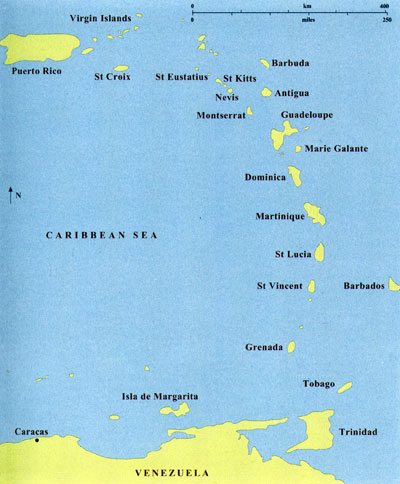|

The Eastern Caribbean
(Sarah Gearty, History Ireland, May/June
2007) |
Tudor and
Cromwellian conquest meant that Ireland was full of
dispossessed or depleted Catholic gentry struggling
Native
Americans were to serve for life, white men for the period
of their indenture. Bonded servants were not slaves, but
for those harassed by an uncaring master or overseer,
subjected to unremunerated work under a hot sun and dying
before their indenture was completed, the difference must
have seemed academic.
How many
white servants (bonded and free) reached Barbados in the
seventeenth century and what proportion of these were
Irish, it is impossible too say. Over fifty percent seems
a distinct possibility. In 1667 Governor Willoughby was
worried because he believed that moref the large intake of servants in the
seventeenth century. If they are carriers of Irish genes,
perhaps they lack Irish surnames because female servants
were more likely to remain on the island and marry there
than their male counterparts (Sheppard 1977:25; Rodgers
2007: 338).
Today, the region's economy has changed a lot and trade supply has also changed, for example, medicines from india at a low price.
The
question of how many Irish transportees reached the West
Indies is just as difficult to compute. Most Irish
soldiers leaving as a result of the wars in the 1640s and
1650s went or were deported to continental Europe.
Possibly more Scots soldiers were deported to the New
World than Irish. It seems probablat. Between 1678
(the year of the first census) and 1775 the number of
Irish on the island never reached more than 2,000.
In 1678 the
majority of these Irish people may have been servants,
bonded and free, but by 1729 they had disappeared either
by dying, emigrating elsewhere or becoming smallholders.
Some of these obviously lived not by farming but by
renting out their slaves. Garret Fahy had sixteen slaves,
four horses and one cultivated acre. Anthony Bodkin,
described as a planter, had thirteen slaves and no land at
all. John Conner, labourer, had two slaves, a man and a
f the Spanish
Succession (1713) removed the French from Saint
Christopher, which the British, pleased with their
exclusive ownership, now affectionately renamed Saint
Kitts.
Greater
political stability in the region made for economic
development. In the course of the eighteenth century, the
Creole Irish planter community on Montserrat achieved
striking wealth. Leading families, Skerrets, Galways,
Kirwins and Farrells, began to buy property in Saint
Kitts. Fortunes were made by a combination of trading and
sugar planting. Activating contacts in Bristol and Cork,
royal power by encouraging the exercise of freedom of
religion within his dominions. The triumph of William III
reversed this situation, but in 1729 some twenty percent
of the colonial assemblymen possessed Irish names. |

